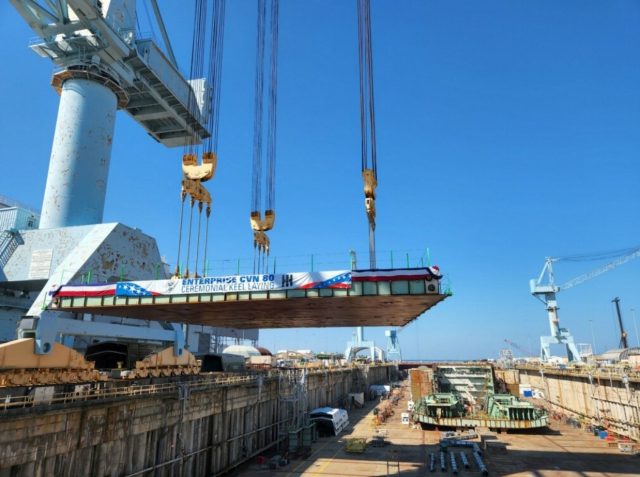The US Navy has ceremoniously laid the keel for the third Ford-class aircraft carrier, future USS Enterprise (CVN 80), in a ceremony at the HII-Newport News Shipyard (NNS), in Newport News.
With the words, “I hereby declare the keel of the United States Ship Enterprise truly and fairly laid,” Olympians Simone Biles and Katie Ledecky chalked their initials on respective steel plates, which were then embossed by welders and affixed to the keel of the future USS Enterprise (CVN 80).
Ledecky attended the historic keel laying ceremony for the nation’s most advanced aircraft carrier in person, while Biles participated via a pre-recorded message from the World Champions Center in Spring, Texas. Five years earlier, on Aug. 24, 2017, Biles and Ledecky attended CVN 80’s first cut of steel ceremony, marking the initial major construction milestone for the Enterprise—the third ship in the USS Gerald R. Ford (CVN 78)-class of aircraft carriers.
On Saturday, after NNS welders finished welding the athletes’ initials on small, steel plates, Ledecky gave the command for operators to lower the 688-ton keel unit into the dry-dock. This section of the ship will support the forward half of the Enterprise, when the CVN 80 is fully assembled. The ceremonial plates will be affixed permanently to the ship’s keel.
Work on the Enterprise has been progressing on schedule, according to the navy, since NNS loaded the Enterprise’s keel unit during the ship’s first “super-lift,” on April 5th, 2022. With the first main structural member in place, workers have continued erecting the aircraft carrier in the dry dock by joining together a series of pre-outfitted modules.
“This is a significant milestone for the ship and the class,” said Rear Adm. James P. Downey, program executive officer for aircraft carriers (PEO CV). “The shipyard has taken lessons from building USS Gerald R. Ford and John F. Kennedy and applied them directly to constructing Enterprise. Our industry partners are applying the best practices of integrated digital shipbuilding into the process, and that enables efficiencies, both in terms of cost and schedule.”
Capt. Brian Metcalf, who leads the Gerald R. Ford-Class New Construction Program Office, offered examples of the ship’s many construction efficiencies. “Procuring CVN 80 and CVN 81 as part of a two-ship buy has already allowed us to realize efficiencies in the early construction process. And building the aircraft carrier with fewer, but larger, pre-outfitted super-lifts has been a major improvement that contributes to streamlining the construction of CVN 80 over previous Ford-class hulls.”
Enterprise is the first of a two-carrier block buy for the navy, with work also underway at NNS on the second, Doris Miller (CVN 81).
CVN 80’s dry-dock erection program, for example, comprises 131 such super-lifts. In comparison, crews erected USS Gerald R. Ford (CVN 78) by means of 162 super-lifts, and the future USS John F. Kennedy (CVN 79) with 155.
Future USS Enterprise will be the ninth US Navy warship to bear the name, with the first being a sloop-of-war, commissioned in 1775, after her capture from the British during the American War of Independence. The last Enterprise (CVN 65), served as the world’s first nuclear-powered aircraft carrier from 1961–2017, and is currently moored nearby in the shipyard awaiting the results of an environmental impact statement and a Navy decision on disposal options.
Gerald R. Ford-class aircraft carriers displace approximately 100,000 tons and are 1,092 feet in length, with a beam of 124 feet; and can operate at more than 30 knots. Designed to be operated by a smaller crew than previous aircraft carrier, each Ford-class ship will afford significant savings in total ownership costs during a 50-year service life, when compared to the Nimitz-class ships they are designed to replace.
The future USS Enterprise is scheduled to replace the USS Dwight D. Eisenhower (CVN 69), which is currently slated for inactivation in 2029.



























